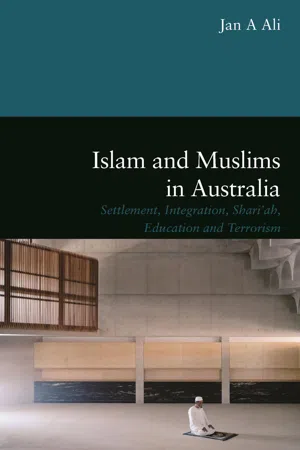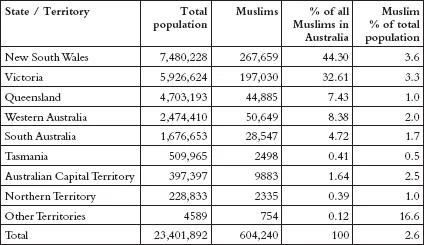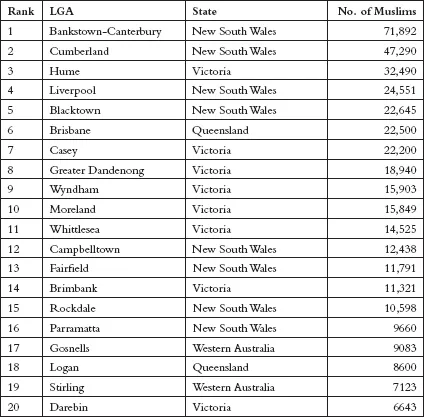![]()
Part 1
Muslim settlement, immigration, and the emergence of Islam in Australia
![]()
Chapter 1
History of Muslim settlement in Australia
Muslim presence in modern Australia cannot be denied. Muslims form a significant part of the wider mix of Australia’s diverse multicultural society.
The latter part of the twentieth century saw a new kind of Muslim movement to Australia, one in which citizens of Muslim countries arrived in growing numbers in search of business prosperity, employment, refuge and, in some instances, religious freedom. However, they were often seen as a foreign people and were kept on the margins of society away from public visibility. It is only recently, perhaps within a few short decades, that Muslims have emerged as the second-largest religious group in Australia.
Awareness and appreciation of this new Australian reality has materialised slowly. Some difficult adjustments, for both Muslims and non-Muslims, have had to be made and much work is still in progress. It is important to note, though, that it is no longer sustainable to deem Muslims and their faith as ‘foreign’, and the long-held view of them as the ‘Other’ is no longer defensible, if it ever was. They must now be accepted as part of the fabric of Australian society. Muslims are fellow citizens and equal members of society and have a rightful place as part of Australia’s Judeo-Christian tradition.
Like many immigrants and ethnic and religious communities before them, Muslims have encountered serious difficulties in defining and determining their place in Australian society. They have been confronted with issues of identity, loyalty, worship, education, religious law and civil rights. Despite the commonalities of experience among Muslims who have made Australia home, there are also distinct differences. Demographically, Islam is the fastest-growing religion in the world as well as in Australia. Relatively invisible in Australia only a few decades ago, Muslims today have significantly contributed to reconfiguring the geographical landscapes of many cities and towns through building mosques, Islamic centres and Muslim schools; the donning of Muslim attire; and introducing halal (permissible) commodities in places such as halal restaurants and Muslim nursing homes. Increasingly, we are seeing that the major Muslim communities and cities of the world of Islam are not only Jakarta, Cairo and Karachi but also Sydney, Melbourne and Brisbane.
Prominent and permanent Muslim settlement in Australia has its origins in the post–World War II national mass immigration program initiated by the federal government to recruit immigrants for national economic development and advancement. Muslims have arrived from diverse social, cultural and national backgrounds, making them the most diverse religious group in Australia.1 Thus, it is more fitting to say that Muslims in Australia are numerous communities rather than a single community. These communities have emerged from places within Australia where large concentrations of Muslims live. They have developed around different languages, nationalities, ethnicities and community origins. For instance, large populations of Lebanese Muslims are found in Lakemba, a suburb in south-western Sydney, and of Pakistani Muslims in Rooty Hill, in Sydney’s west.
In this chapter I look at Muslim settlement patterns over a period stretching from the fourteenth century to now and provide an opportunity to learn how Muslims were introduced to Australia and the processes through which they gradually grew in number and achieved permanency. An understanding of the past is helpful for understanding the present as it gives us a clear perspective on contemporary Muslim reality. A deeper understanding of the origins and growth of Muslim communities in Australia, which I discuss in depth in Chapter 2, is only possible with a coherent narrative of the period, which this chapter provides.
Early Muslims
The pluralistic nature of Islam in Australia belongs to an immigrant culture, and for this reason Islam is a fairly new religious tradition here. Gary Bouma confirms that ‘Islam in Australia is represented by relatively recently arrived immigrant communities’.2 It is true that Muslims have been linked with Australia since before European settlement. Andrew Jakubowicz says, ‘It is feasible that ships from the fleet of Chinese Muslim eunuch admiral Zheng He reached Australia’s north coast in the fifteenth century CE.’3 Nahid Kabir notes that Islam has been documented to have had links with Australia before this time period, perhaps as early as the fourteenth century.4 Macassan fishers from the south-western corner of the Indonesian island of Sulawesi made seasonal trips to Marege (literally ‘wild country’) on the north and north-west coastlines of the Australian continent in search of trepang, the sea slugs commonly known as bêche-de-mer.5 This contact definitely predates European interest in the Australian continent, and Regina Ganter asserts ‘That Macassan contact predates the arrival of the British on the Australian continent is not disputed.’6
Trepang are marine invertebrates well known in Chinese markets for their culinary and medicinal value and supposed aphrodisiacal qualities. Remnants of the influence of Indonesian Muslim trepangers are evident in the cultural traditions of some northern Aboriginal peoples. Ganter notes that the trepangers ‘left profound imprints on the cultures and languages of the far north shores’.7 Referring to Macassan visiting fleets, she says, ‘The crews and captains were predominantly Muslim, and Muslim prayer references still survive in some secret/sacred incantations on the northern Australian shores, alluding to “Allah”.’8 Archaeologists John Mulvaney and Johan Kamminga documented that the Macassan fishers left their mark on several Indigenous communities, evidence of which can be found in the practice of intermarriage and the Macassan influence evident in various local art practices and rituals.9 Annie Clarke, another archaeologist, found in her fieldwork on Groote Eylandt in the Gulf of Carpentaria that due to the frequent exchange between Indonesian Muslim trepangers and the Indigenous people, the latter became more strongly engaged with coast and marine resources.10 Anthropologist Ian McIntosh similarly notes that contact between the two peoples led to Aboriginal people adapting various aspects of Islam.11
Due to their small numbers and temporary residency, and the absence of a fully-formed community structure, these Muslims made unsystematic and only localised impact on Australian social and cultural life.12 The arrival of British colonists in 1788 dashed all possibility of Macassan Muslim growth in Australia. Cross-culturalist Peta Stephenson writes that:
Indigenous and Muslim people [Macassans] traded, socialised and intermarried in this country decades before its white ‘discovery’ and settlement … Above all, Indigenous engagement with Islam has bequeathed to Australia a largely unknown human heritage in the form of memories, precious belongings, bicultural or multicultural identities and spiritual identifications that continue to be proudly invoked by descendants across the country.13
Then came the cameleers, commonly called the ‘Ghans’ (shortened from Afghans). Jakubowicz writes that ‘Muslim Afghans, Pushtu and Dari speakers from the northwestern provinces of British India had been brought to Australia in the mid-nineteenth century as cameleers in support of European exploration and communication.’14 As the Ghan community grew, Durranie Afghans, Tareen Afghans, Pishorie Afghans, Punjabi Indians and Bengali Indians joined gradually.15 These Ghans were pivotal in helping explore the Australian deserts, establish trade and communication routes,16 and industrialise Australia’s interior,17 and in the process formed small Muslim communities called ‘Ghantowns’.18
Compared to the Macassans, the Ghans made a more lasting impact on Australia religiously as they were the first Muslims to institutionalise Islam. The first mosque was built in Marree in northern South Australia in 1882, followed by a ‘Ghantown’ mosque built in 1889 in Broken Hill in outback New South Wales; the latter survives as a museum occupied by the Broken Hill Historic Society.19 The Afghans also built mosques in Adelaide in 1890, Perth in 1904, and 1907 in Brisbane—all of which continue to function as mosques to this day.20
These early mosques symbolised the initial establishment of Islam in Australia. However, the introduction of the railway in the remote interior and the utility truck made camel cartage redundant and hastened the demise of the industry.21 The situation was compounded in the early twentieth century by the malevolent ‘White Australia policy’, which saw a gradual public disappearance of Islam in the country.
Post–World War II Muslim migration to Australia
Muslim settlement proper started after World War II, when the Muslim population began to increase again in Australia. By now, Australian governments and businesses realised that in order for the country to be a part of postwar development, it had to grow demographically and economically. The sourcing of large numbers of migrants as workers, therefore, was related to the dynamics of the global economic position of developed capitalist societies.22 The need for large numbers of migrant workers was not just a national issue but directly related to the nature of Australia’s economy and its positioning in the global capitalist world. At the end of World War II, Australia was a developing capitalist society that had the necessary preconditions, financial structure, political will and natural resources to develop industrially. It did not, however, have adequate labour resources or capital to achieve such development.23
While the mass migration program initiated in 1947 sought immigrants of British origin, the ambitious targets gradually saw the net expand and become more global and culturally diverse. As a result, Australia started receiving immigrants from other overseas countries and Muslim immigration was part of the process.
Although Albanians—former citizens of the Ottoman Empire—had arrived in Australia in the 1920s and 30s, their numbers were too minute to make much difference to the national landscape.24 Aside from the largely Muslim (Malay) inhabitants of the Indian Ocean’s Cocos (or Keeling) Islands who transferred to Australia in 1955,25 Turkish Cypriots were the first Muslim immigrants to start arriving in significant numbers in the 1950s and 60s, followed by more Turkish immigrants between 1968 and 1972.26 Lebanese Muslims followed; they constituted the largest Muslim community in Australia by early 1970 and their numbers continued to grow, particularly after the outbreak of the Lebanese Civil War in 1975.27, 28 The period from 1950 to 1975 saw an increase not only in the Muslim population as such, but also in the number of Muslim professionals and skilled personnel who arrived in Australia, including ‘teachers and engineers from Egypt, doctors from the Indo-Pakistan subcontinent, and tertiary students from Malaysia, Indonesia, Bangladesh, India and Pakistan’.29
It was between 1947 and 1971 that the Muslim population showed real signs of growth, increasing from 2704 to 22,311.30 Then the last quarter of the twentieth century and the first decade of the twenty-first century saw a steep increase. For instance, in 1991 there were 148,096 Muslims, constituting 0.9 per cent of the total Australian population;31 in 1996 there were 200,902 (1.1 per cent);32 in 2001 there were 281,578 (1.5 per cent);33 in 2006 there were 340,392 (1.7 per cent);34 in 2011 there were 476,291 (2.2 per cent);35 and in 2016 there were 604,200 (2.6 per cent).36
Table 1 shows the growth in Muslim population over the course of six censuses: it grew on average by 1.7 per cent of the total Australian population, or 341,910 people, from census 1991 to census 2016. This steady increase has been mainly attributed to immigration, although high birthrates have also contributed. The steady increase in Muslim birthrate in Australia is a significant factor in Muslim population growth: if this trend continues, it is possible that the number of second- and third-generation Muslims could gradually grow over the years and then become an important factor in Australia’s social, economic and political reality.37 Notwithstanding this, it is worth noting that compared to the total Australian population, Muslims are significantly more likely to be ‘first-generation’ Australians, meaning people living in Australia who were born overseas.38
Table 1: Growth change in Muslim population in Australia, 1991–2016
Source: Australian Bureau of Statistics, Censuses 1991–2016
Though Muslims live across the Australian continent, they are mainly concentrated in New South Wales and Victoria (see Table 2) and mainly live in the capital cities.39
Table 2: Australian Muslim population by state/territory
Source: Australian Bureau of Statistics, Census 2016
From Table 2 we can ascertain that Australia’s largest Muslim population lives in New South Wales—44.30 per cent of all Muslims in the country. Within New South Wales, over 50 per cent of the Muslim population lives almost entirely within a radius of 50 kilometres of Sydney, making it the city with the greatest concentration of Muslims in Australia.40 Since the 2016 census there have been some natural demographic changes and these have probably had some impact on the configuration of the radius, leading to an expansion to over 50 kilometres.
To gain further understanding of the demographic characteristics of Australian Muslims and an insight into where the vast majority of the Muslim population resides, the information in Table 3 is invaluable. It provides an overarching picture of Muslim population in each of the top twenty local government areas (LGAs), relating to the number of residents identifying as ‘Muslim’ in the 2016 census.
Table 3: Top 20 LGAs in terms of number of Muslim residents, 2016
Source: Australian Bure...



